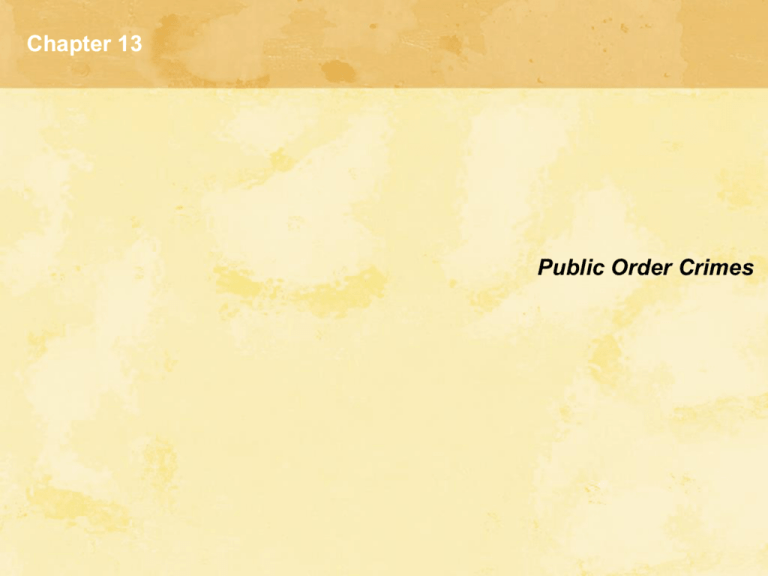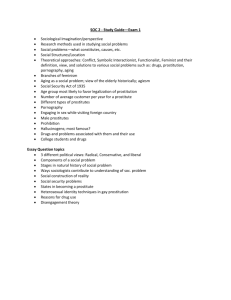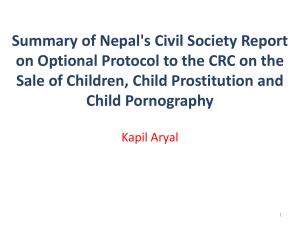
Chapter 13
Public Order Crimes
Law and Morality
•
Debating Morality
Scholars argue pornography, prostitution, and drug use erodes
the moral fabric of society.
What is offensive to some is accepted by others
Influence of cultural values help regulate definitions of morality
Law and Morality
•
Social Harm
Certain behaviors run contrary to social norms, customs, and
values (I.E. Prostitution)
The “seven deadly sins” are not illegal (lust, gluttony, avarice,
sloth, envy, pride, or anger)
Acts viewed as being illegal are viewed as a threat to morality
and referred to as public order crimes
Homosexuality
•
“Gaybashing” is a term used to describe violent acts directed at
people because of their sexual orientation
Homosexuality refers to erotic interests in members of one’s own
sex
Attitudes toward Homosexuality
Sodomy (biblical prohibitions)
Homophobia refers to extreme negative overreaction to
homosexuals
Fear of homosexuals is attributed to ignorance about
homosexuality
Homosexuality
•
Homosexuality and the Law
Homosexuality is no longer a crime in the U.S. (Robinson v.
California)
Defense of Marriage Act declared that states are not obligated to
recognize same-sex marriages performed in other states (1996)
Military policy of “don’t ask, don’t tell”
Homosexuality
•
Is the Tide Turning?
Surveys reveal the majority of Americans support equality for
same-sex couples
Recent Supreme Court decisions illustrate the changing attitudes
toward the gay lifestyle (Romer v. Evans and Lawrence v. Texas)
Immoral acts are distinguished from crimes based on the social
harm they cause
Homosexuality
•
Moral Crusaders
Vigilantes held a strict standard of morality in the early West
Public order crimes are often shaped by moral crusaders (moral
entrepreneurs) who suggest their way is righteous
Acts are illegal because they violate the moral standards of those
in power and those who try to shape public opinion
Paraphilias
•
Bizarre or abnormal sexual practices involving recurrent sexual urges
focused on:
Nonhuman objects (i.e. underwear or shoes)
Humiliation or the experience of receiving or giving pain
(sadomasochism)
Children or others who cannot grant consent
Paraphilias
•
Outlawed Sexual Behaviors
Asphyxiophilia: oxygen deprivation for enhancement of sexual
gratification
Frotteurism: rubbing against or toughing a nonconsenting person
in a crowd
Voyeurism: spying on a stranger who is disrobing or engaged in
sexual behavior
Exhibitionism: sexual pleasure from exposing genitals
Sadomasochism: pleasure derived from receiving or inflicting pain
Pedophilia: pleasure from sexual activity of prepubescent children
Prostitution
•
•
Is defined as granting nonmarital sexual access, established by
mutual agreement for money
Incidence of Prostitution
Number of arrests for prostitution has been declining (80,000
annually)
• Changes in sexual mores
• Prevalence of sexually transmitted diseases
Prostitution
•
International Sex Trade
Soaring demand for “sex tourism” in developing countries
Traffickers from Southeast Asia and Eastern Europe may import
up to 50,000 women and children into the U.S. yearly
Prostitution
•
Types of Prostitutes
Streetwalkers: (lowest paid and most vulnerable)
Bar girls: (B-girls spend their time working out of bars)
Brothel prostitutes: (supervised by a madam)
Call girls: (aristocrats of prostitution that can make up to $1,500
per night)
Escort services/Call Houses: (fronts for prostitution rings)
Circuit travelers: (groups of 2 or 3 traveling to lumbar or labor
camps)
Skeezers: barter drugs for sex
Massage parlors/photo studios: fronts for prostitution
Cyber Prostitutes (Internet facilitated contact)
Prostitution
•
Becoming a Prostitute
Broken homes and sexual abuse
Poor school performance
Drug abuse
Prostitution
•
Child Sexual Abuse and Prostitution
Prostitution has been linked to sexual trauma at an early age
Children who flee the home are vulnerable to life on the streets
Many remain in the trade due to being resigned to their fate
Prostitution
•
Controlling Prostitution
Federal Mann Act (1925)
Misdemeanor punishable by a fine or short jail sentence in most
states
The Violent Crime Control and Law Enforcement Act of 1994
made it illegal to travel abroad to engage in sex with a child
Prostitution
•
Legalize Prostitution?
Feminists have conflicting views (male domination to free choice)
Advocates of both views argue penalties should be reduced
Some argue legalization creates security for prostitutes
Pornography
•
Obscenity is defined as “deeply offensive to morality and
decency…designed to incite to lust or depravity”
First Amendment protections
What is considered obscene today may be considered socially
acceptable in the future
Pornography
•
Child Pornography
Most controversial and reprehensible of the business
“Kiddie Porn” is considered uncontested pornography and
becoming widespread on the Internet
Philip Jenkins suggests enforcement efforts should be focused on
the suppliers and not the users
Pornography
•
Does Pornography Cause Violence?
Most research has found little conclusive evidence of a link
between violence and pornography
Some research suggest viewing pornography may actually serve
as a safety valve for those with violent impulses
Some evidence suggests that pornography leads to aggression
toward women (James Fox and Jack Levin)
Pornography
•
•
Pornography and the Law
The First Amendment protects free speech and expression
The Miller doctrine holds that the state of local jurisdiction must
specifically define obscene conduct in it statute and the
pornographer must engage in that behavior
Controlling Pornography
Get tough policies may actually be have a reverse effect making
pornography more desirable
Zoning laws to restrict placement of businesses
Pornography
•
Technological Change
Recent reports place pornography at a $10 billion per year
business
Communications Decency Act was ruled to unconstitutionally
restrict free speech
The Child Pornography Prevention Act of 1996 (CPPA)
Substance Abuse
•
When Did Drug Use Begin?
Mesopotamia used opium 4000 years ago
Arabs used marijuana at the time of the Crusades
In the U.S. Morphine was used for pain
Religious creeds deemed intoxicating substances as
unwholesome
Substance Abuse
•
Alcohol and Its Prohibition
Temperance movement led to the Volstead Act which defined
intoxicating beverages as any having more than one-half of one
percent
Prohibition failed in part due to the efforts of organized crime to
supply illicit liquor
In 1933 the 21st Amendment repealed Prohibition
Substance Abuse
•
The Extent of Substance Abuse
•
Monitoring the Future
Drug use declined from a high point in 1980 until 1990 when it
began to increase until 1996
Marijuana is the most widely used illicit drug
About one-third of seniors report using marijuana in the prior year
National Household Survey of Drug Abuse
In 2003, 8.3 percent of the general population aged 12 or older
were drug users
National Center on Addiction and Substance Abuse
Alcohol abuse begins at an early age
More than 31.5 percent of high school students admit to drinking
at least once a month
•
•
Figure 13.1 Trends in the Annual Prevalence of
Teenage Illicit Drug Use
Substance Abuse
•
•
Casa Survey
• Teens who are sexually active are more likely to drink, more
likely to get drunk, more likely to have tried marijuana, and
more likely to smoke
• Teens who spend 25 hours a week or more with
boyfriends/girlfriends are more likely to drink, get drunk, have
tried marijuana, and more likely to smoke
• Girls with boyfriends two or more years older are more likely
to drink, get drunk, have tried marijuana, and more likely to
smoke
Are the Surveys Accurate?
Drug users may boast about their behaviors
NSDUH misses people who are homeless, in prison, or drug
rehabilitation
Figure 13.2 Past Year Illicit Drug or Alcohol Dependence or Abuse
by Age and Gender: 2003
Substance Abuse
•
Weblink
www.casacolumbia.org
Substance Abuse
•
AIDS and Drug Use
Widespread habit of needle sharing among IV users
Threat of AIDS has less effect on changing the behaviors among
the poor, high school dropouts, and other disadvantaged groups
Recently observed decline in drug abuse may be restricted to one
segment of the population
Substance Abuse
•
The Causes of Substance Abuse
Subcultural view: lower-class addiction
Psychological view: impaired cognitive functioning and
personality defects
Genetic factors: parental biological heritage
Social learning: observing parental drug use
Problem behavior syndrome: maladjusted and emotionally
distressed
Rational choice: enjoy getting high
Gateway drugs: Research may not support this view
Substance Abuse
•
Types of Drug Users
Adolescents who distribute small amounts of drugs
Adolescents who frequently sell drugs
Teenage drug dealers who commit other delinquent acts
Adolescents who cycle in and out of the justice system
Drug-involved youth who continue to commit crimes as adults
Outwardly respectable adults who are top-level dealers
Smugglers
Adult predatory drug users who are frequently arrested
Adult predatory drug user who are rarely arrested (winners)
Less Predatory drug-involved adult offenders
Women who are drug-involved offenders
Substance Abuse
•
Drugs and Crime
Research suggests a link between drug use and crime such as
domestic assault, armed robbery, and homicide
User surveys indicate that youths who abuse alcohol are most
likely to engage in violent behavior in their life course
Surveys of prison inmates indicate nearly 80 percent are lifelong
substance abusers
The direction of the drug link is uncertain (drugs lead to crime or
crime leads to drug)
Substance Abuse
•
Drugs and the Law
In 1914 the Harrison Narcotics Act restricted the importation, and
sale of opiates except for medicinal purposes
Narcotic is defined as any drug that produces sleep and relieves
pain
Various federal laws have attempted to increase penalties for
drug smugglers and limit the manufacture of newly developed
substances (Controlled Substances Act 1984)
Substance Abuse
•
Drug Control Strategies
Source Control: aimed at importation
Interdiction Strategies: interception at the borders
Law Enforcement Strategies: aimed at large scale drug rings
Punishment Strategies: deterrence through harsh punishment
Community Strategies: community programs to restore a sense of
civil justice
Drug-Testing Programs: testing of employees
Treatment strategies: intensive therapy efforts
Employment programs: vocational rehabilitation and work support
programs
CNN Clip - Prescription Drugs Online
Substance Abuse
•
Drug Legalization
War against drugs has expensive ($500 billion over the past 20
years)
Banning drugs creates networks of manufacturers much like
Prohibition (Ethan Nadelmann)
If legalized, drugs could be controlled and regulated by the
government
Crime rate would likely drop as users no longer need less cash to
support their habit
Some suggest legalization might increase drug usage based on
availability






